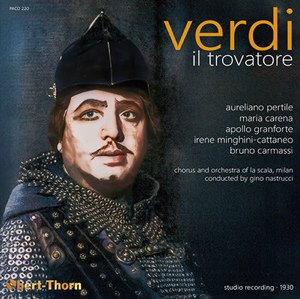
Giuseppe Verdi (1813-1901)
Il trovatore
Manrico – Aureliano Pertile (tenor)
Leonora – Maria Carena (soprano)
Conte di Luna – Apollo Granforte (baritone)
Azucena – Irene Minghini-Cattaneo (mezzo-soprano)
Ferrando – Bruno Carmassi (bass)
Chorus and Orchestra of Teatro alla Scala, Milan/Gino Nastrucci*
rec. 24 October – 26 November 1930, Conservatorio, Milan, Italy
Producer and Audio Restoration Engineer: Mark Obert-Thorn
Full score and vocal score enclosed
Pristine Audio PACO220 [2 CDs: 115]
This from HMV was one of two “complete” (actually cut by around fifteen or twenty minutes) studio recordings made in 1930 – the other was made by Columbia. It was previously favourably reviewed on this site by Göran Forsling and included in my survey of recordings of the opera, which is quoted in the note to this new issue. I remarked there, “here are some of the finest voices from the 30’s, conveying the drama and immediacy of a live performance without the attendant disadvantages of live recording.
This sound is particularly striking for its age -and you can hear a quartet of unparalleled splendour. I had never heard of Maria Carena, but she is a proper singer of the old school, who occasionally reminds me of Muzio without quite the beauty of tone of that greatest of sopranos. Both vocal registers are fully developed and she knows exactly what she is doing; her technique is excellent. The other singers are better known: Pertile (a Toscanini favourite) occasionally allows his vibrato to get away from him and produce the effect of singing sharp, and Granforte makes wonderfully impressive sounds without much subtlety, but they are nonetheless mighty impressive. Minghini Catteo is a paragon among Azucenas; as good as any I have ever heard. There are numerous cuts, of course, and Pertile transposes “Di quella pira” down a whole tone, which is a bit naughty and robs it of some excitement – but that is hardly unprecedented. Nastrucci’s* conducting fairly rattles along but that’s what this warhorse needs – and he is by no means insensitive.”
Having already reviewed this in its previous incarnation, my criteria here are simple and bifold: to check if my response still holds and comment on Mark Obert-Thorn’s remastering for Pristine. First the singing: I stand by my assessment above but note that I did not comment on Bruno Carmassi’s big, black vibrant bass. His assumption of Ferrando is instantly impressive but I should in passing note that like Pertile, the very vibrancy of his voice means that he sometimes goes sharp.
Regarding the sound, Obert-Thorn is somewhat less interventionist than Andrew Rose; this has not been rendered into Ambient Stereo and there is still some audible background hiss but the orchestra now emerges more clearly to match the voices. It really is remarkably present for a recording getting on for a century old and there is no question in my mind but that we are getting a really good idea of how these Old School singers sound. This Pristine remastering is now the best option for hearing a recording which opens a window onto a vanished past.
Ralph Moore
Availability: Pristine ClassicalPrevious review: Göran Forsling (December 2024)
*Carlo Sabajno was originally credited as conductor but we now know that he conducted only two sides (CD 1 tracks 9-10 and 13-14) and the rest was “ghost-conducted” by his assistant Nastrucci, and I have changed my survey accordingly.


















